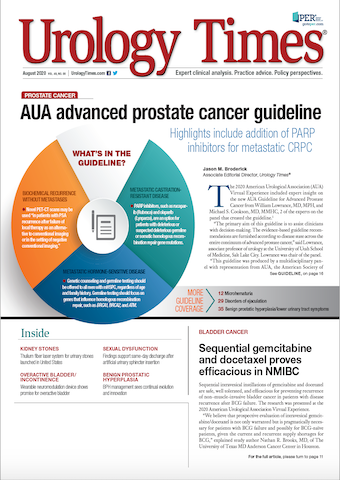Publication
Article
Urology Times Journal
18F-DCFPyL–PET/CT demonstrates effective diagnostic performance in biochemically recurrent prostate cancer
Author(s):
The phase 3 CONDOR study demonstrated excellent diagnostic performance with 18F-DCFPyL–PET/CT in men with biochemically relapsed prostate cancer, even at very low PSA values.
Michael J. Morris, MD

Imaging with 18F-DCFPyL–PET/CT is able to detect and localize disease in men with biochemically recurrent prostate cancer who had no evidence of disease on standard-of-care imaging, and it led to a change in the management of most patients who participated in the phase 3 multicenter CONDOR study.1
Of 208 men with a rising prostate-specific antigen (PSA) level after definitive therapy and negative or equivocal standard-of-care imaging who were enrolled in CONDOR, the correct localization rate (CLR) with 18F-DCFPyL–PET/CT was 85% to 87% and the detection rate was 59% to 65%.
Further, 63.9% of the patients had a change in intended management after their 18F-DCFPyL–PET/CT scan.
Data from the study were presented by Michael J. Morris, MD, during the 2020 American Society of Clinical Oncology Virtual Scientific Program.
“CONDOR met its primary end point. Indeed, it well exceeded it. It demonstrated excellent diagnostic performance of PyL–PET in men with biochemically relapsed prostate cancer, even at very low PSA values,” said Morris, clinical director of the Genitourinary Medical Oncology Service, Division of Solid Tumor Oncology, at Memorial Sloan Kettering Cancer Center in New York. “It clearly showed superiority to the standard imaging these men received as part of their local work-ups. And the results demonstrated that actionable intervention was furnished to clinicians in order to make clinically significant decisions.”
There is ample evidence that prostate-specific membrane antigen (PSMA)–PET is superior to current standard imaging modalities for the detection of prostate cancer, Morris said. “However, PSMA–PET imaging has not yet earned regulatory approval in the United States,” he stated. PyL is a PSMA-directed PET tracer under investigation.
Men with rising PSA after definitive therapy and negative or equivocal standard-of-care imaging were eligible for CONDOR. Patients were required to have a PSA level ≥0.2 if they had undergone radical prostatectomy (RP) or a PSA level ≥2.0 if they were treated with radiation therapy or cryotherapy. The primary end point was CLR, defined as percentage of patients with a 1:1 correspondence between at least 1 lesion identified by PyL–PET/CT and the composite standard of truth (pathology, correlative imaging, or PSA response). PyL scans were read by 3 blinded independent central readers.
About 85% of the 208 patients underwent RP, either alone or with radiation. Median PSA level of the cohort was 0.8 ng/mL, and 68.8% had a PSA level <2.0 ng/mL. Some 27.9% had received at least 1 prior systemic therapy.
Detection of disease as manifested by a positive 18F-DCFPyL–PET/CT scan was 65.9%, 59.6%, and 59.1% by the 3 readers.
The prespecified criterion for CLR success was for the lower limit of the 95% CI to exceed 20% for at least 2 of the 3 readers. “For every reader, the CLR was excellent,” said Morris. “The lower bound of the 95% CI was well in excess of the 20% benchmark.” The study therefore met its primary end point.
The CLRs were 85.6% (95% CI, 78.8%-92.3%), 87.0% (95% CI, 80.4%-93.6%), and 84.8% (95% CI, 77.8%-91.9%) by the 3 readers.
Some 64% of the evaluable patients had a change in intended management due to the scan.
“It is important to recognize the clinical significance of these changes: 21% of these patients had a goal of care changed from a noncurative goal to a curative goal,” said Morris. “Twenty-eight percent had a change from salvage local therapy alone to either supplementation with or replacement by systemic therapy; 24% of patients had a change from observation to initiating therapy and 4.4% the converse.”
Disclosures: Progenics Pharmaceuticals, Inc, provided funding for the study. Dr Morris is a consultant/adviser for Advanced Accelerator Applications, Astellas Pharma, Bayer, Blue Earth Diagnostics, Endocyte, ORIC Pharmaceuticals, Tokai Pharmaceuticals, and Tolmar; has received institutional funding from Bayer, Corcept Therapeutics, Endocyte, Progenics, Roche/Genentech, and Sanofi; and has received travel, accommodations, and expenses from Bayer and Endocyte. For full disclosures, see bit.ly/31R12Ww.
Reference
1. Morris M, Carroll P, Saperstein L, et al. Impact of PSMA-targeted imaging with 18F-DCFPyL-PET/CT on clinical management of patients (pts) with biochemically recurrent (BCR) prostate cancer (PCa): results from a phase III, prospective, multicenter study (CONDOR). J Clin Oncol. 2020;38(15 suppl; abstr 5501). doi:10.1200/JCO.2020.38.15_suppl.5501
































